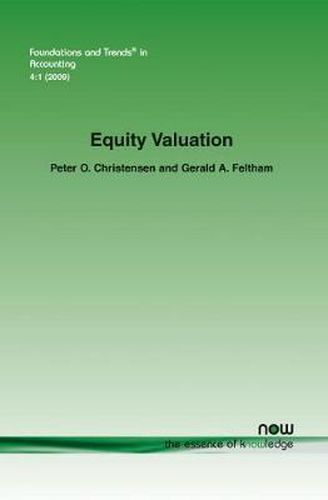Readings Newsletter
Become a Readings Member to make your shopping experience even easier.
Sign in or sign up for free!
You’re not far away from qualifying for FREE standard shipping within Australia
You’ve qualified for FREE standard shipping within Australia
The cart is loading…






This title is printed to order. This book may have been self-published. If so, we cannot guarantee the quality of the content. In the main most books will have gone through the editing process however some may not. We therefore suggest that you be aware of this before ordering this book. If in doubt check either the author or publisher’s details as we are unable to accept any returns unless they are faulty. Please contact us if you have any questions.
Equity Valuation reviews and critically examines the standard approach to equity valuation using a constant risk-adjusted cost of capital and develops a new valuation approach discounting risk-adjusted fundamentals using nominal zero-coupon interest rates. It is organized as follows:
Chapter 2 (Risk-Adjusted Discount Rates) reviews standard valuation models based on risk-adjusted discount rates. Chapter 3 (Multi-Period Asset Pricing Theory and Accounting Relations) examines key results from multi-period asset pricing theory in discrete-time, and shows how equity valuation models can equivalently be based on free cash flows or accrual accounting numbers. Based on these results, the authors derive an accounting-based multi-period equity valuation model presented in Chapter 4 (An Accounting-Based Multi-period Equity Valuation Model) with equilibrium risk-adjustments determined by prices of aggregate consumption claims. Chapter 5 (Equity Valuation with HARA Utility) includes a general equilibrium analysis of a setting in which the investors have HARA utility, and aggregate consumption and residual operating income are jointly normally distributed. A set of appendices follows including Appendix B that extends the setting to preferences with external habit formation (which recently has gained popularity in asset pricing theory). Appendix C, which discusses the relationship between risk-adjusted expected cash flows and certainty equivalents.
$9.00 standard shipping within Australia
FREE standard shipping within Australia for orders over $100.00
Express & International shipping calculated at checkout
This title is printed to order. This book may have been self-published. If so, we cannot guarantee the quality of the content. In the main most books will have gone through the editing process however some may not. We therefore suggest that you be aware of this before ordering this book. If in doubt check either the author or publisher’s details as we are unable to accept any returns unless they are faulty. Please contact us if you have any questions.
Equity Valuation reviews and critically examines the standard approach to equity valuation using a constant risk-adjusted cost of capital and develops a new valuation approach discounting risk-adjusted fundamentals using nominal zero-coupon interest rates. It is organized as follows:
Chapter 2 (Risk-Adjusted Discount Rates) reviews standard valuation models based on risk-adjusted discount rates. Chapter 3 (Multi-Period Asset Pricing Theory and Accounting Relations) examines key results from multi-period asset pricing theory in discrete-time, and shows how equity valuation models can equivalently be based on free cash flows or accrual accounting numbers. Based on these results, the authors derive an accounting-based multi-period equity valuation model presented in Chapter 4 (An Accounting-Based Multi-period Equity Valuation Model) with equilibrium risk-adjustments determined by prices of aggregate consumption claims. Chapter 5 (Equity Valuation with HARA Utility) includes a general equilibrium analysis of a setting in which the investors have HARA utility, and aggregate consumption and residual operating income are jointly normally distributed. A set of appendices follows including Appendix B that extends the setting to preferences with external habit formation (which recently has gained popularity in asset pricing theory). Appendix C, which discusses the relationship between risk-adjusted expected cash flows and certainty equivalents.